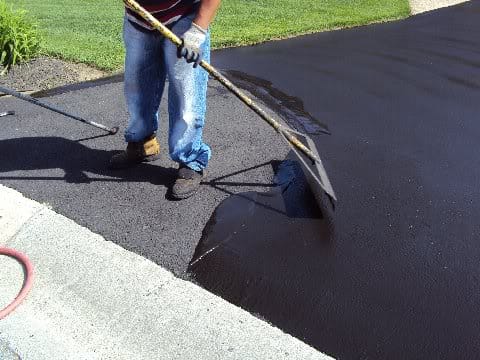Extend Sidewalk Lifespan: Ingenious Cold Mix Asphalt Sealing
Extend Sidewalk Lifespan: Ingenious Cold Mix Asphalt Sealing
Blog Article
Cold Mix Asphalt Vs. Hot Mix Asphalt: Which Is Right for You?

Composition Distinctions
Cold mix and hot mix asphalts vary dramatically in their composition, with distinctive attributes that impact their efficiency and applications. Cold mix asphalt is produced by emulsifying the asphalt binder with water and an emulsifying representative before mixing it with aggregate. This approach enables the asphalt to be convenient at reduced temperature levels, making it ideal for short-term repair work and for use in colder climate conditions. Hot mix asphalt, on the other hand, is manufactured at high temperature levels, normally between 300-350 ° F, which aids to achieve far better compaction and an extra long lasting final product. The hot mix asphalt manufacturing process includes heating the aggregate and asphalt binder individually before combining them at the asphalt plant.
Moreover, cold mix asphalt tends to be less thick and extra versatile than warm mix asphalt. This flexibility makes it better fit for areas with greater levels of movement, such as driveways or roads with heavy web traffic. On the other hand, hot mix asphalt is known for its high toughness and resistance to rutting and cracking, making it a favored option for highways and high-traffic roads where long life is crucial.
Installation Refine Variances
The procedure of mounting chilly mix and hot mix asphalt exhibits notable variances in their treatments and requirements. In contrast, warm mix asphalt demands a much more fancy installation procedure. Due to the home heating needs, warm mix asphalt installments are commonly carried out by professionals with customized devices, making sure a much more irreversible and structurally audio outcome.
Toughness and Durability Factors
When taking into consideration asphalt alternatives, longevity and longevity are essential elements to examine for long lasting sidewalk performance. Warm mix asphalt (HMA) is known for its extraordinary durability and long life. The high temperatures throughout the laying and blending procedure permit better compaction, leading to a denser and more powerful pavement framework. This results in HMA being much more resistant to rush hour lots, extreme weather, and the results of aging contrasted to cold mix asphalt (CMA)
In terms of long life, HMA commonly outshines CMA as a result of its remarkable stamina and resistance properties. HMA sidewalks have a longer life span, calling for less frequent fixings and maintenance, which can equate to cost try this out financial savings in the future. Furthermore, HMA pavements are more quickly adjustable to satisfy particular task needs, even more enhancing their durability.
Price Factors To Consider
Taking into consideration the financial ramifications is a crucial facet when evaluating the selection between warm mix asphalt (HMA) and chilly mix asphalt (CMA) for sidewalk projects. While the initial expense of hot mix asphalt is normally higher than that of cold mix asphalt, HMA often provides a more economical solution in the future because of its premium durability and durability. HMA is understood for its capacity to withstand rush hour tons and extreme weather problems, minimizing the need for constant fixings and maintenance. On the various other hand, chilly mix asphalt is much more economical upfront but may call for even more regular patching and resurfacing, leading to greater upkeep costs with time.
In enhancement to material prices, it's necessary to think about the expenditures related to installment and maintenance when contrasting HMA and CMA. HMA generally requires specific equipment and knowledgeable labor for appropriate installment, which can impact general task prices. On the other hand, CMA is easier to function with and can typically be applied utilizing easier strategies, potentially decreasing installation expenditures. Inevitably, the choice between HMA and CMA must take into account not simply the initial price but also the lasting economic ramifications to identify one of the most cost-efficient choice for the certain pavement job.
Environmental Impact Contrast
Contrast of the ecological effects between warm mix asphalt (HMA) and chilly mix asphalt (CMA) exposes distinct distinctions in sustainability methods. HMA manufacturing calls for high temperatures, leading to raised energy usage and greenhouse gas emissions.
In addition, the usage of CMA usually involves recycling existing asphalt sidewalk, advertising resource preservation and lowering the quantity of waste sent to garbage dumps. By deciding for CMA over HMA, roadway construction jobs can contribute positively to environmental conservation efforts.
Final Thought
Finally, the selection visit between chilly mix asphalt (CMA) see this website and warm mix asphalt (HMA) relies on various elements such as structure, installation process, toughness, durability, expense, and environmental effect. cold mix asphalt. While CMA provides a cost-efficient and fast solution for small repair services, HMA ensures remarkable resilience and longevity for rush hour areas. Take into consideration these variables very carefully to establish which kind of asphalt is the right selection for your paving needs
:max_bytes(150000):strip_icc()/barricade-tape-sealed-driveway-big-56a583145f9b58b7d0dd3d87.jpg)
Taking into consideration the monetary effects is a crucial aspect when assessing the option between hot mix asphalt (HMA) and chilly mix asphalt (CMA) for sidewalk projects. While the first expense of hot mix asphalt is generally greater than that of cold mix asphalt, HMA commonly gives an extra cost-efficient option in the long run due to its exceptional resilience and longevity. asphalt repair.Comparison of the environmental influences between warm mix asphalt (HMA) and cold mix asphalt (CMA) reveals distinct differences in sustainability practices.In conclusion, the choice between chilly mix asphalt (CMA) and hot mix asphalt (HMA) depends on numerous factors such as composition, installation procedure, longevity, longevity, expense, and ecological effect
Report this page